This post is a long time coming — I returned from Africa nearly one year ago. And even though I tracked every dime I spent on the continent, it’s taken me until now to actually tally up the numbers.
Back when I was planning this trip, I roughly estimated a budget of $12,000 for 4.5 months in Africa. Turns out I was a few grand off — I spent a total of $15,340. This includes EVERYTHING: all airfare, all tours, all coffee cups consumed. Here’s how the numbers break down by country:
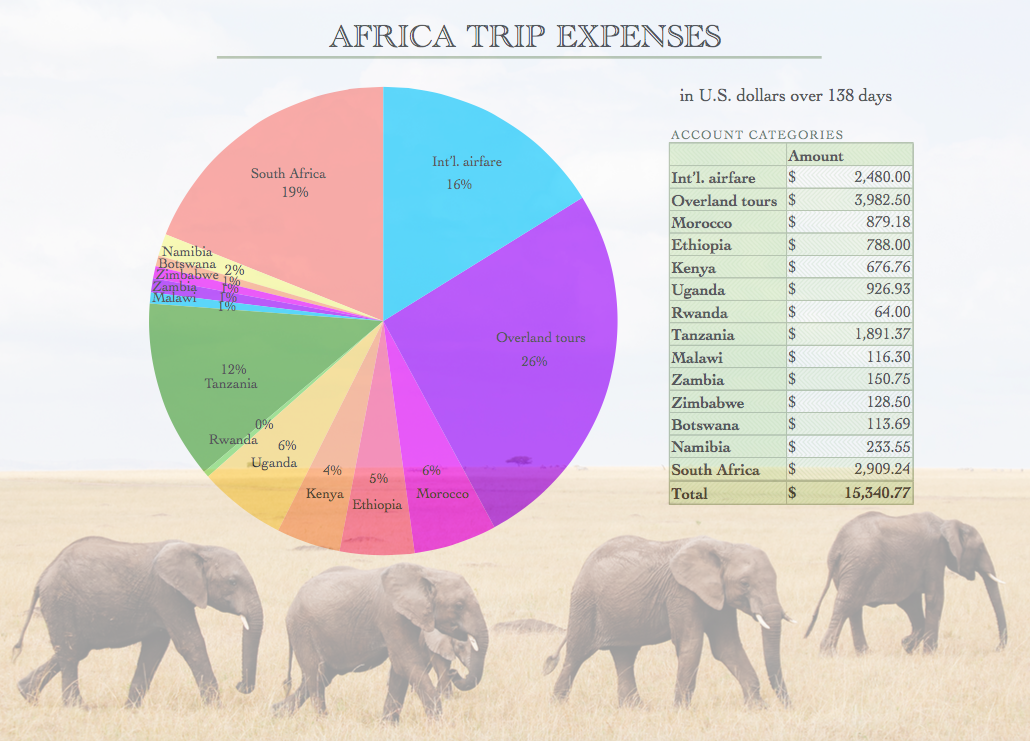 For more info about pre-trip costs and a definition of my travel style, read more here.
For more info about pre-trip costs and a definition of my travel style, read more here.
As with my 2013 RTW trip budget analysis, I liken the expense of extended travel to paying for college (or in my case, grad school might be a more apropos analogy) — it’s an education that is just as important as instruction taught on a brick-and-mortar campus. The world is an open classroom and homework is a joy; my assignment in Africa was to engage with my surroundings and be fully present while documenting the experience to share with others, in hopes that it inspires people to seek similar adventures of their own. When you factor in all that I saw and did over these 4.5 months — summiting Kilimanjaro after an overnight climb in the freezing dark, visiting remote tribes in southern Ethiopia, standing mere feet from enormous gorillas in the Ugandan jungle, scamping down sand dunes in Namibia — I’d say that $15,000 was a bargain. Compare that to the cost of attending Yale ($63,250 annually for the 2014-2015 academic year including room & board) or or even a state school like UCLA ($33,900 for CA residents / $58,600 for out-of-staters), and I rest my case. Travel is worth your time and money; you will matriculate a more engaged citizen of the world. And here’s the easiest part — you don’t have to leave the country, or spend thousands of dollars, because the rewards are similar with domestic travel — the idea is to disrupt your routine, go somewhere you’ve never been, and feel the spark of discovery. Travel will awaken something in you, even if it’s only a few hours’ drive from where you live. Even if it’s “just” camping, a nearly free activity. Even it it’s trying a new kind of food you’ve never had before, getting a literal taste of another culture. Travel isn’t just for folks with disposable income, or a blogger looking for discounted trips — it’s available to all of us, but the onus is on us to seek it out within the parameters (time, budget, work, kids) in our own lives.
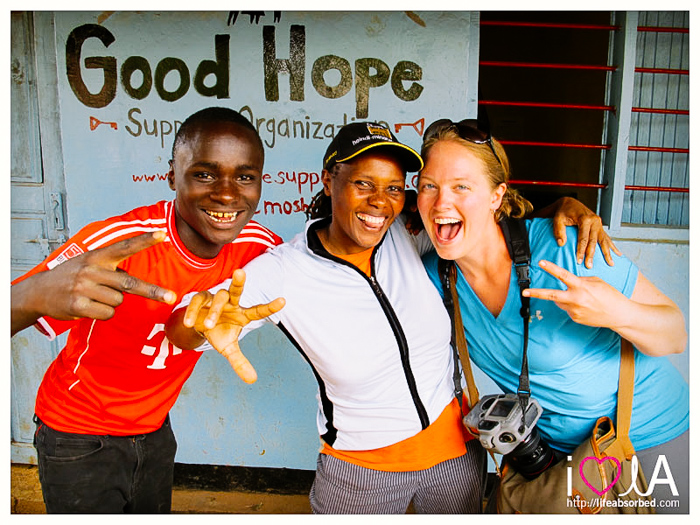 Okay, enough philosophizing. Let’s get down to the nitty, gritty details.
Okay, enough philosophizing. Let’s get down to the nitty, gritty details.
I completed the majority of my Africa travel on an overland truck, watching the continent reveal itself through my window. But I did take a number of flights, which accounted for 16% of my overall Africa budget — I spent a total of $2,480 on airfare. The most expensive flights were from the U.S. to Morocco ($725), and then from Morocco to Ethiopia ($687). Interestingly, it wasn’t all that expensive to fly back to the States from South Africa — I spent under $500 for that flight on Qatar Airways, a more upscale airline compared to others I’ve traveled.
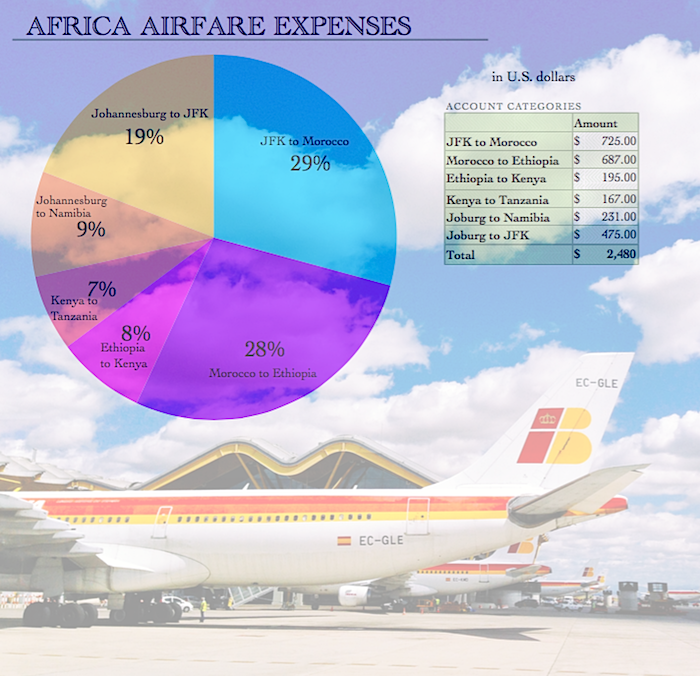
You may have noticed that I stopped sharing my expense reports for most of Africa — I did Morocco, Ethiopia, and South Africa because it was easy to breakdown those numbers, but the figures got murkier when I traveled via overland tours through multiple countries. I grappled with how to best share that part of my budget in a way that both accurately reflected what I spent in each place and also would be helpful to someone planning their own trip to Africa. So I saved that overland budget info for this financial wrap-up post.
In total, I spent just over a quarter of my entire Africa budget (26%) on three overland tours — $3,982 for 60 days traveling through eight countries. I scored some big discounts in exchange for my photography, which I’ll detail below. That price includes activity fees and the Serengeti safari, but not gorilla and chimp trekking ($660) as that’s listed under the Uganda budget. That number also includes local payments, which tour participants pay upon arrival; many companies do this because it’s more efficient if the guide pays for certain tour activities in cash. As I wrote in my overland FAQ, this kind of tour is budget-friendly — participants camp (or you can pay more for an accommodated package) and everyone chips in with chores and food prep. But it’s still fairly pricey. Africa is not a cheap place to travel unless you REALLY rough it, hopping on chicken buses with locals. That is a totally valid way to see these countries, but for reasons of both efficiency and safety, I was happy to jump on various overland tours to cover this part of the continent. Here is a graphic showing the three tours that I did:
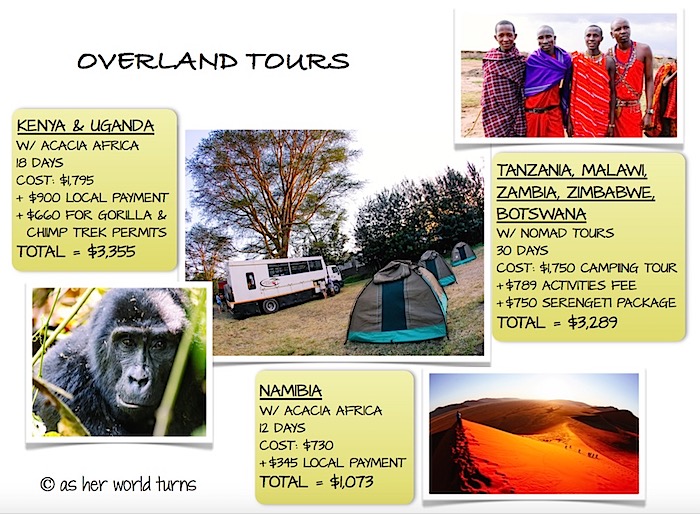
For reference, here is a photo recap of each tour:
A few things to keep in mind:
- The Kenya & Uganda trip is expensive primarily because the gorilla encounter costs $600 and the chimp encounter costs $60. If you cut those out (or at least the gorilla encounter), it’s a much cheaper area to travel. But of course you’ll want to see the gorillas, so my tip is to go during the off-season where you can score permits for half-price and save a couple hundred dollars. The weather might not be as good, but you’re in the jungle anyways so rain and mud add to the atmosphere. Another big cost of this tour was 3 days, 2 nights in the Masai Mara National Park in Kenya — it was a very pretty place, but those couple of days were not cheap. If you cut that out of your itinerary (Acacia has a 14 day tour excluding Masai Mara) then you’ll save a few hundred bucks. I loved the Masai Mara but if you’re on a budget or your time is limited, sometimes you have to make tough choices.
- Tanzania is the most expensive place to visit in Africa. Their national parks charge so much more money and, as I discussed here, they’re not entirely worth it if you are going to other parks in Africa. Don’t get me wrong — the Serengeti and Ngorongoro Crater are outstanding places — it’s just that they overcharge based on their reputation and number of tourists flocking here each year, but there are equally (I’d argue even more) stunning parks in Kenya or Zambia for half the price. Various overland tours structure their Serengeti packages differently, but Nomad Tours offers a 4-day, 3-night package for $750 (I think Acacia Africa’s is 3-days, 2 nights for $500). I’m not saying don’t go there. I’m just saying that if you’re on a budget and planning to see other parts of Africa then weigh this decision carefully before committing $500-$750. The other countries in this itinerary — Malawi, Zambia, Zimbabwe, and Botswana — are much cheaper to travel.
- Namibia is quite a bargain compared to these other two overland tours — average daily cost is only $89 compared to $186 on the Kenya & Uganda tour, and $110 for the Nairobi to Joburg tour. If you only have two weeks and want to go somewhere truly spectacular in Africa and get some bang for your buck, go to Namibia. It’s one of my favorite places in the world.
The figures listed above are full-price with no discount as of 2014, the year I traveled to Africa. If you did all three of these tours full-price, it would be a total of $7,717 for 60 days of travel through eight countries. I scored a few blog discounts that really helped me to afford this — Acacia Africa waived the base fee on both tours ($1,795 for Kenya & Uganda, $730 in Namibia) and only charged me the local payment plus gorilla & chimp permit. So I paid $1560 for 18 days in Kenya & Uganda and $345 for 12 days in Namibia. In exchange, I gave them access to all of the best photos from my trip to use as they wished — and now my photos are on their website, their 2015 brochure, and their social media accounts. Nomad Tours offered me much less of a deal on their tour, but I took it because their dates fit my timeline and I wasn’t able to work out a better deal elsewhere — I got 30% off the base price of the camping tour, which saved me $525. So I paid a total of $2,764 (including the Activities Fee and Serengeti Package) to go on their 30-day tour from Nairobi to Johannesburg. They also extended the 30% discount to my sister, and she wrote about the trip on her blog, too. Taking into account the discounts I received, I paid $3,982 for these three tours, which works out to $66.36 per day for 60 days of overland travel.

But I traveled elsewhere before, after, and between these three tours. So now I’ll go country-by-country to weigh in on expenses and flag anything to look out for if you want to plan a trip to these places. I’ll go in chronological order since that’s how my brain works.
One quick note regarding visas, as I mention the costs below — I did not arrange any visas in advance; I got each one upon arrival in each country, whether flying into an airport or crossing the border with our overland tour. If I had gone to Mozambique, I would have had to sort that out in advance at the embassy in Pretoria, South Africa because Mozambique will not allow Americans to enter without a pre-approved visa (citizens of other countries don’t have to jump through that particular hoop). But other than that, you can just show up and pay for a visa; no need to arrange it in advance from home if you’re a citizen of the U.S. or many other nations (Europe, Australia, etc.). Here is my visa cheat sheet for the areas of Africa I visited, but note that these apply to U.S. citizens and might be different for visitors from other countries:
- Morocco — no visa required; can stay up to 3 months
- Ethiopia — visa on arrival ($20) at Addis Ababa airport (not border crossings); single entry for 90 days
- Kenya — visa on arrival ($50 single entry; $100 multiple entry); single entry good for 3 months
- Uganda — visa on arrival ($50 single entry)
- Rwanda — visa on arrival (free for American citizens)
- Tanzania — visa on arrival ($100)
- Malawi — free visitor permit for 30 days upon arrival
- Zambia — visa on arrival ($50 single entry — I’d read it was less, but that’s what they charged me)
- Zimbabwe — visa on arrival ($30 single entry; $45 double entry)
- Botswana — visa not required; 30 day entrance stamp on passport; can stay up to 90 days in 1 year
- Namibia — visa not required; can stay 90 days
- South Africa — visa not required; can stay 90 days
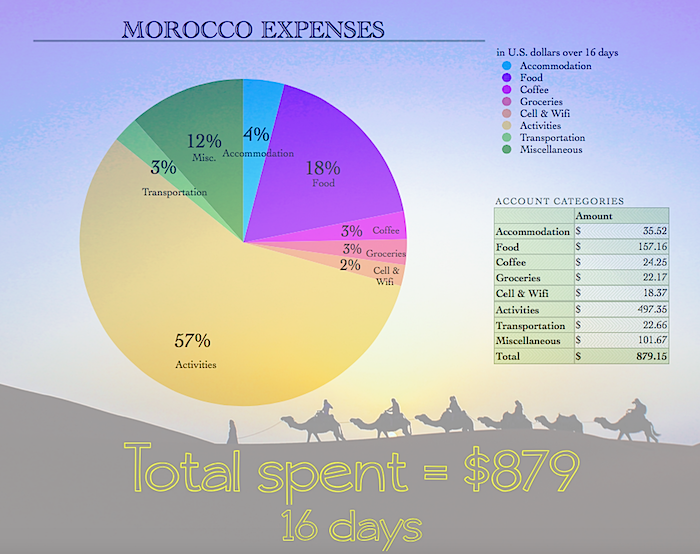
MOROCCO (spent an average of $54.94 USD per day)
Morocco is one of the few countries for which I wrote a full-on expense report, so check that if you want more detailed info.
- Blog / photography discounts in Morocco: generous discount on 15-day tour ($1,000 off tour cost), one night’s stay at Riad Andalla ($75).
- Several tour companies offer the same 15-day itinerary that covers most of Morocco; each tour costs in the ballpark of $1,500 and includes basic hotels and most meals. (I went with Nomadic Tours and they were great.) That works out to just over $100 per day to see a gorgeous country — it’s a steal, and a big part of the reason I consider Morocco a high value destination. Thanks to a photography and blogging discount, I spent only $55 per day to visit this country.
- I stayed in a fancy riad (traditional Moroccan house with a garden or courtyard) for one night at the end of my tour — it’s a popular type of accommodation here and totally worth the splurge. The one I stayed in runs around $75 USD a night for the cheaper rooms.
- Since Morocco is a Muslim country, there is not much opportunity to purchase alcohol. This is good for the wallet.
- Budget extra money for souvenirs. I personally have a ‘no souvenirs’ policy when I travel long-term because I simply don’t have space in my luggage, but if you’re just flying to Morocco and back then take advantage of their excellent leather products or famous Berber rugs. They have a better selection of souvenirs than most countries I’ve been to.
- I purchased a local SIM card at the airport with Maroc Telecom for around $18; the package included data, local calls, and texts.
- Miscellaneous expenses in Morocco include photo tips ($3), driver tip ($25), guide tip ($35), 10 postcards ($3.50), and 10 international stamps ($20.50).
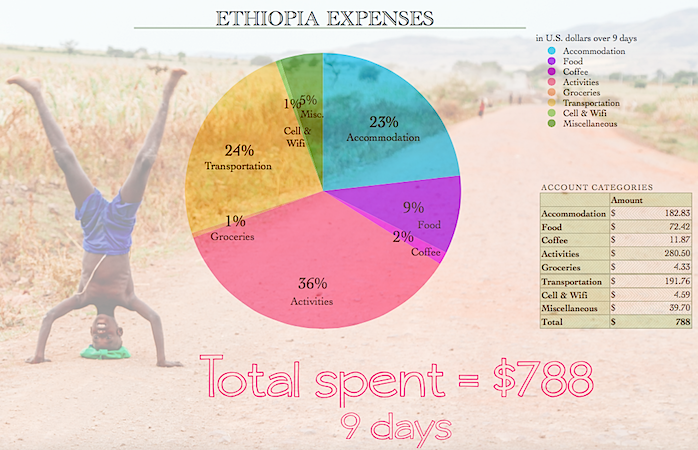
ETHIOPIA (spent an average of $87.55 USD per day)
Ethiopia is another country for which I wrote a proper expense report, so click here if you want to read about it in detail.
- No blog discounts for Ethiopia.
- Big tip regarding airfare: if your international arrival or departure flight is booked on Ethiopian Airlines, then you will get a significant discount on domestic flights — the only catch is that you have to book those domestic flights in person at the Ethiopia Airlines office once you get into the country. It’s a pretty steep discount; I paid $67 for a one-way flight from Addis Ababa to Arba Minch (gateway to the tribes of Omo Valley), but that same flight would have cost $160 if I’d booked it from the States. I ran into two issues with this. The first flight I wanted was fully booked and I had to wait two extra days for the next flight… so maybe pay extra to book one in advance and ensure you get on your first flight. Second, I initially purchased several domestic flights, but the airlines canceled the first one because not enough people had booked; that delay forced me to rethink my entire itinerary and I had to cut out my visit to Lalibela. Major bummer. So beware that even if you’ve booked a domestic flight, there is a chance it might be cancelled at the last minute. Prepare to be flexible.
- My daily average for Ethiopia was $87 per day, but that number was inflated because it cost $150 per day for a guide and driver to visit tribes in Omo Valley (I split the cost of that 3-day trip with my friend Mike so it was only $75 each per day).
- Accommodation is cheap — you can find pensions for under $10 per night (squat toilet), or splurge on a private room at Mr. Martin’s Cozy Guesthouse for $24/night in Addis Ababa. Meals are cheap; you can get a nice dinner for $5 or less, and true local food for $2.
- Transportation around the capital is pricey; every time I got into a cab it was $5 no matter where I was going within a certain radius. Normally I like to walk around cities but there was mud everywhere in Addis Ababa so taxis usually made more sense.
- I did not get a local SIM card in Ethiopia. The communication network in this country is government-run and not very efficient; wifi works at dial-up speeds.
- Miscellaneous expenses include visa on arrival ($20), a movie ticket ($2.50), photo tips for Omo Valley tribes ($15), and laundry ($2).
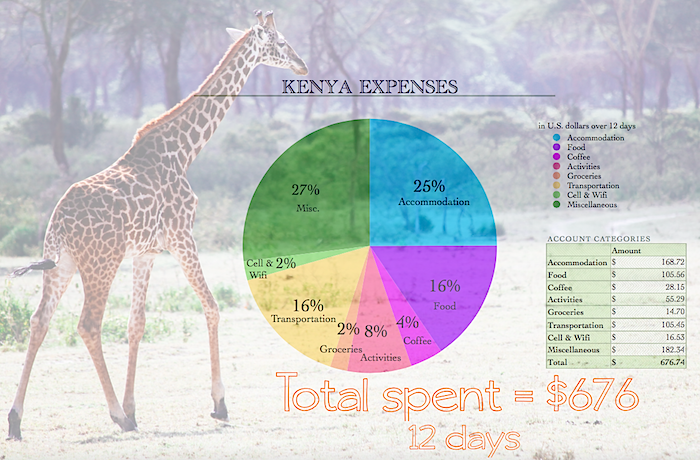
KENYA (spent an average of $52.05 USD per day, not including price of overland tour)
And here is where we shift into the overland part of my trip. The “daily average” numbers reflect what I spent in the country aside from the overland tour cost, since the tour covers multiple countries and is accounted for in its own slice of the pie in the overall budget graph at the top of this post.
- No blog discounts in Kenya.
- Normally my accommodation budget is very low on these overland trips countries because the camping is already paid for in the tour cost, but I had a few days in Nairobi before and after the tour where I paid for my own room in a guesthouse. That’s why I spent $168 on accommodation in Kenya.
- Visa note — if you’re only going to Kenya, you can purchase a visa on arrival at the airport for $50. If you’re planning to also visit Uganda and/or Rwanda, get the $100 East African Visa that covers multiple entrances to all three countries. It will save you money.
- I did purchase a SIM card in Kenya to get on the local network; I went with Safaricom and spent around $16 for 1.5 GB of data plus local calling.
- Examples of miscellaneous costs: visa on arrival ($50), new travel lock and adapter plugs ($10), 8 postcards and stamps ($16.40), new hiking boots for Kilimanjaro ($43), two new paperback books ($21.40).
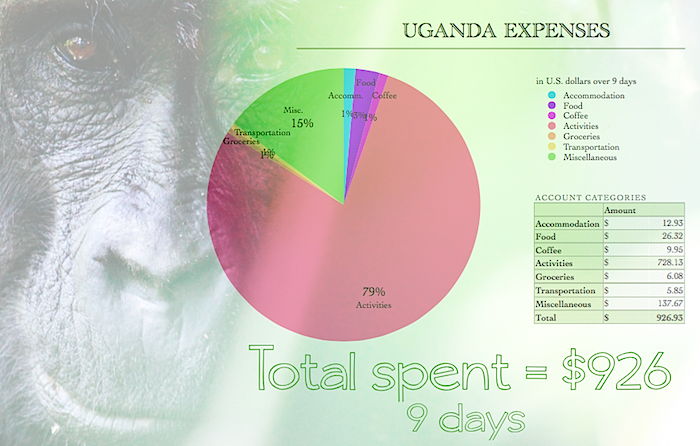
UGANDA (spent an average of $92.69 USD per day, not including price of overland tour)
- There’s one giant outlier in my Uganda budget, and that’s the $600 I spent to go gorilla trekking. That number throws off all the data here, as without it Uganda is a very budget-friendly country — when you take out the gorillas, I only spent a little over $300 here in 9 days. That includes $60 for chimp trekking and $65 for rafting the Nile.
- Blog discounts in Uganda: I saved $85 total on my white water rafting trip and sunset cruise tour; they normally cost $150 combined but I was charged $65 in exchange for photo and blog coverage.
- Again, consider getting the East African Visa instead of the Uganda visa — it’s relatively new, and it’s good for multiple entrances to Kenya, Uganda, and Rwanda. I only found out about it once our overland tour began… I wish I’d known this was an option before I paid $50 for my Kenya visa the previous week.
- I did not purchase a SIM card in Uganda.
- Miscellaneous items include: East African Visa for Kenya, Uganda, Rwanda ($100), gumboots for gorilla trekking ($12), gorilla trekking t-shirt ($15), postcards & stamps ($11).
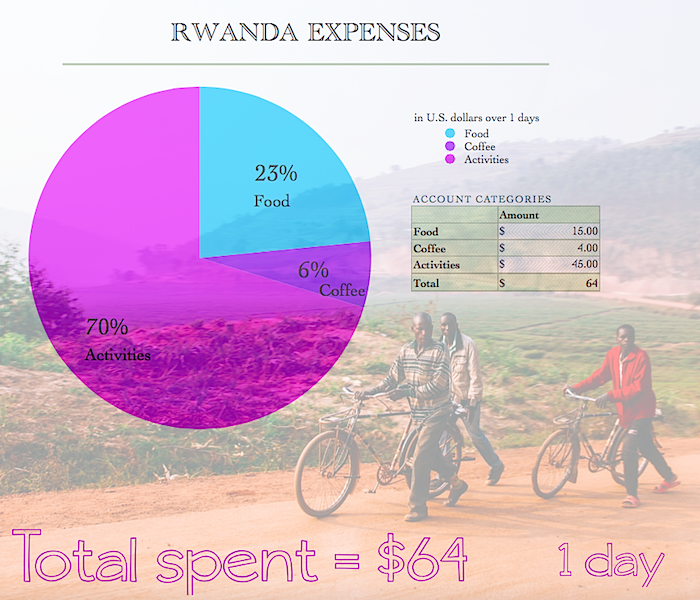
RWANDA (spent an average of $64 USD per day, not including price of overland tour)
- I’ll keep this brief — I only spent a few hours in Rwanda so there isn’t much to share. The visa on arrival is free for Americans, but most other nationalities in my group had to pay around $20 USD, I think, unless they had the East African Visa. I spent $45 for this Rwanda day trip (including admission to the genocide museum + photo fee), which was kindly organized by our Acacia Africa guides even though it was not formally part of the tour. Lunch at the famous hotel that the film Hotel Rwanda was based on cost $15; they accepted USD. A latte at the genocide museum was $4. That covers everything I spent here. No blog discounts.
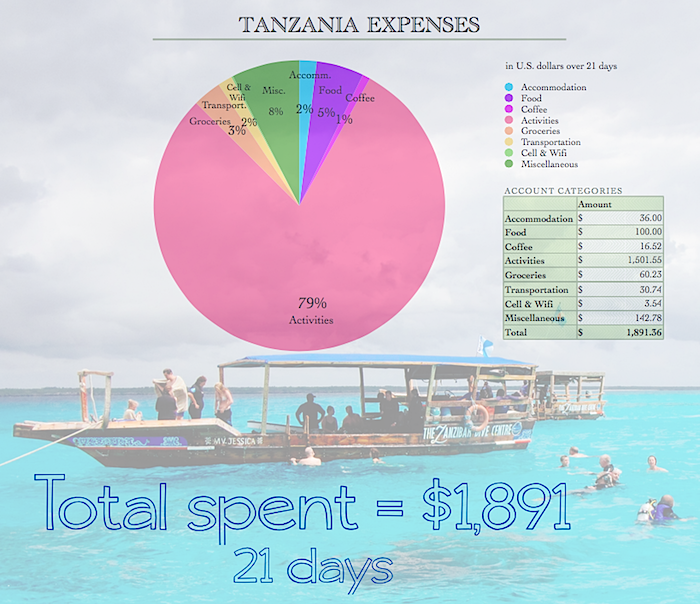
TANZANIA (spent an average of $85.97 USD per day, not including price of overland tour)
- Blog discounts in Tanzania: about half off my Kilimanjaro hike (savings of $821), balloon ride over the Serengeti ($500), one night in a unique barn accommodation ($24), scuba dive discount on Zanzibar (savings of $65).
- One major event takes up that enormous “Activities” slice of the pie… hiking Kilimanjaro. I paid $1054 for the actual climb, plus $300 for tips (that’s the average tipping amount). While the Serengeti & Ngorongoro Crater package costs $750, I accounted for that in the overland budget shown in the very first graph on the top of this page. Other activities included the Zanzibar spice tour ($15) and tour of Stone Town in Zanzibar (also $15) — both were arranged through my overland tour, but were considered optional activities so we had to pay a little extra. I also scuba dived on Zanzibar and they charged half-price ($65); the normal cost is around $130 for two guided dives, including the hour-long boat ride each way and all scuba gear rental equipment.
- I did not get a SIM card in Tanzania, although I wanted to and wished I had figured it out. My sister and I flew into the tiny airport at Moshi to climb Kilimanjaro and there was not a place to purchase SIM cards; after that, I didn’t investigate it and gave up.
- Oof, the visa is expensive here — $100 just for this one country. Tanzania is banking on the irresistible tourism draw of Kilimanjaro and the Serengeti to rake in those visa dollars. Its neighboring countries charge half of that for visas.
- Miscellaneous items include: visa on arrival ($100), rental of hiking poles and duffel bag for Kilimanjaro ($22), Kilimanjaro t-shirt ($10), 9 postcards and stamps ($10.85).
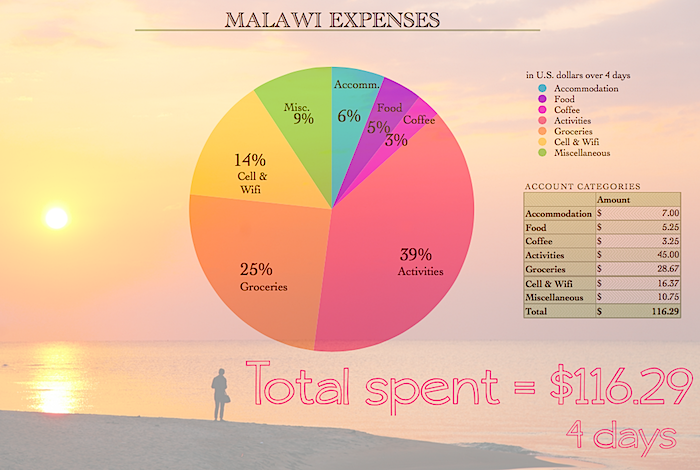
MALAWI (spent an average of $29.07 USD per day, not including price of overland tour)
- No blog discounts for Malawi.
- I did not get a SIM card in this country; we didn’t stay long enough to warrant it. Beware that the wifi in this country is painfully slow, more so than some of the other places I visited on this trip. And most places make you pay for it.
- We stopped at a grocery store almost every day on our overland trip, hence the $28 spent on groceries. Probably half of that is bottles of red wine and the other half chocolate… not kidding. All of our meals were covered on the overland tour so these grocery visits just supplemented the food provided.
- Activities include one scuba dive in Lake Malawi for $45.
- No visa fee for this country!
- Examples of miscellaneous items: school donation ($2.50) and hospital donation ($2.50) on our village tour, 3 stamps and postcards ($5.75).
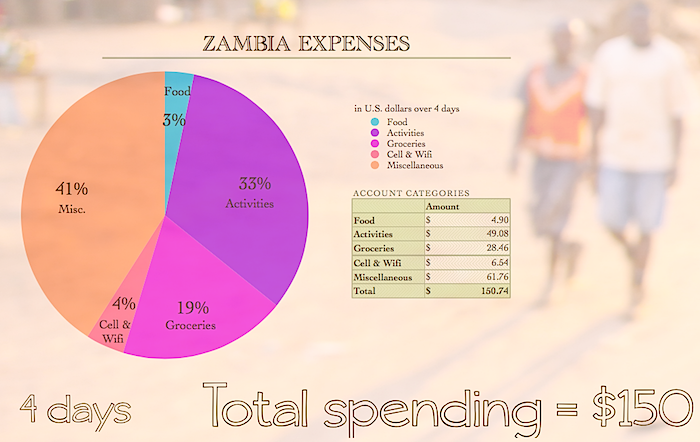
ZAMBIA (spent an average of $37.68 USD per day, not including price of overland tour)
- No blog discounts for Zambia.
- I did not get a SIM card in this country; we didn’t stay long enough to warrant it.
- I spent $45 to go on an extra safari game drive our first morning at South Luangwa National Park, and it was the best $45 I could have spent in this country. About half of our group skipped it because we were already scheduled to go on a sunset safari later that day (included in the price of the tour), and people wanted to sleep in. But I am so glad I got up at 5:30am to participate — we had up-close encounters with elephants, lions, giraffes, and hippos. There weren’t many other jeeps out so it was way less crowded than the Serengeti and Ngorongoro Crater. It was the most relaxing game drive throughout my time in Africa.
- I did not get any coffee during these four days in Zambia… sad face. I think I had instant coffee once or twice on the overland truck during this period.
- Miscellaneous expenses include: visa on arrival ($50), 5 postcards and stamps ($11), tribe donation ($2) on our village visit.
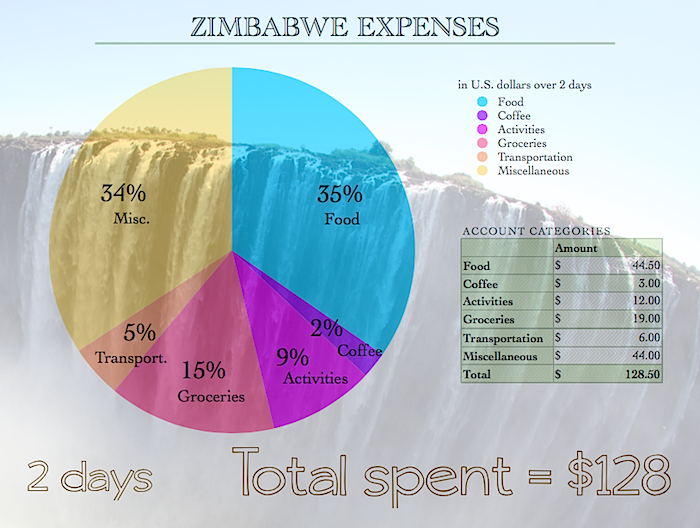
ZIMBABWE (spent an average of $64.25 USD per day, not including price of overland tour)
- Blog discounts for Zimbabwe: helicopter ride over Victoria Falls ($150), sunset cruise on the Zambezi river ($50), flying fox zipline ($40).
- I did not get a SIM card in this country; we didn’t stay long enough to warrant it.
- There are so many optional adventure activities at Victoria Falls — bungee jumping, walking with lions, riding elephants, croc cage diving, white water rafting, swimming in the Devil’s Pool or Angel’s Armchair, and more. Make sure to budget for whichever ones tickle your fancy; they’re not cheap and you’ll want to do a few of them. One other thing to keep in mind — Victoria Falls straddles the border of Zambia and Zimbabwe, and some activities are only available on one side of the falls. If you have a multiple-entry visa then you can go back and forth between countries freely, but if you have a single-entry visa then you have to pay each time you go over the border.
- If you don’t want to shell out big bucks for adventure-related activities, then you can simply walk around the rim of Vic Falls. It was included in the price of our overland tour but otherwise costs around $30 USD. It’s a pretty incredible way to see the Falls.
- Miscellaneous items include: visa ($30), 8 postcards and stamps ($13).
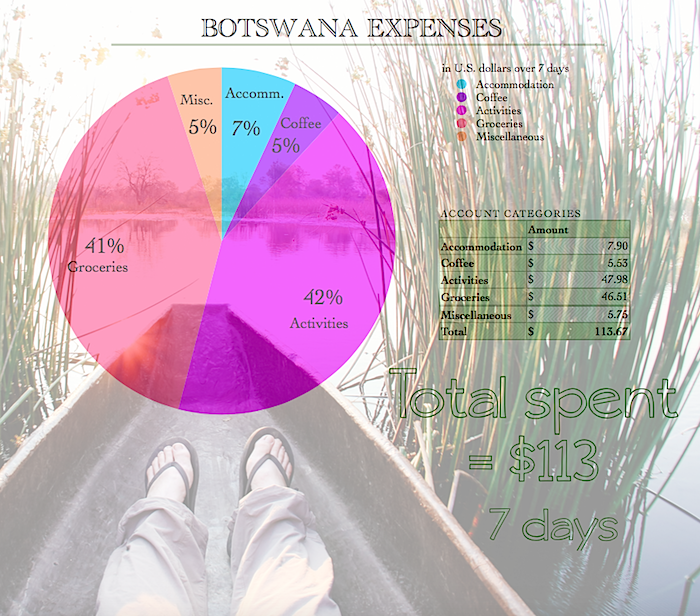
BOTSWANA (spent an average of $16.24 USD per day, not including price of overland tour)
- No blog discounts for Botswana.
- I did not get a SIM card in this country.
- Since the extra game drive in Zambia was so successful, I paid $45 for an additional one at Chobe National Park in Botswana… and it was totally not worth it. Since game drives are different every single time, you never know what animals you might see, but on this particular day we saw very little at Chobe. However the sunset river cruise at Chobe — included in the overland tour price! — is awesome. Like, truly outstanding; I was captivated by the immense variety of wildlife on display.
- By far the best part of Botswana was the Okavango Delta; we took a 3-day, 2-night trip and traveled via mekoro (dugout canoes) and camped in nice tents with beds. I did the standard tour (which was included in the price of the overland trip) but you can spring for luxury camping and a scenic plane ride deeper into the Delta for an enhanced experience.
- No visa fee for this country!
- Examples of miscellaneous items purchased: 3 stamps and postcards ($3.83), pumice stone for my gross scaly feet after months of campground showers ($2).
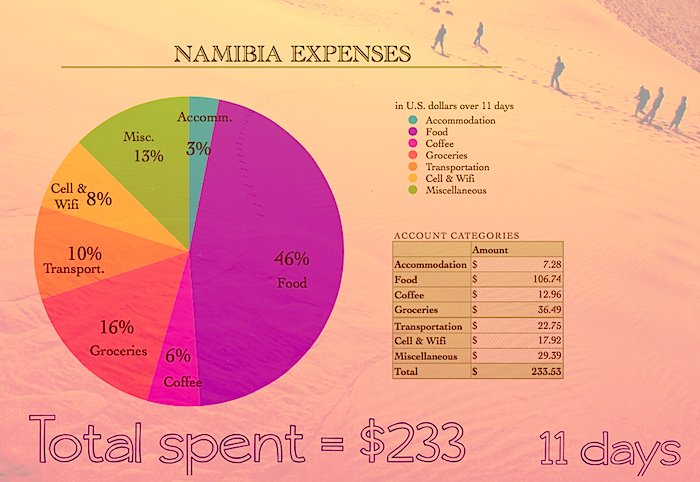
NAMIBIA (spent an average of $21.23 USD per day, not including price of overland tour)
- Oh Namibia, you beautiful, sandy country. This is a high value destination that appeals to me even more than the countries of East Africa (Kenya, Uganda, Tanzania). The scenery is unparalleled — the sweeping sand dunes of Sossusvlei, the towering rocks of Spitzkoppe, the breathtaking views of Fish River Canyon. And the wildlife is on par with the rest of Africa too… check out the watering hole at Etosha National Park for a huge variety of animals. If you have just a short period of time to visit Africa, consider going to Namibia on a tour like I did — in 11 days you will see so much, and it will only set you back around $1,100 (plus international flights from your home country). Then maybe tack on a few days in Cape Town before or after, and it’s the perfect trip.
- Blog discounts: quad bike tour over sand dunes in Swakopmund ($60).
- Other activities to keep in mind: many of my tour mates went bungee jumping in Swakopmund, and others went sand boarding on the dunes. I was set with the quad biking experience (it was awesome) but consider budgeting for more adventure activities if that’s up your alley.
- The food slice of that pie graph is rather large, as we several enjoyed meals out in Swakopmund. I also bought several bottles of red wine at grocery stores throughout the tour.
- No visa fee for this country!
- I got a SIM card with MTC at the Windhoek airport upon arrival; it cost around $17 and included 500 MB of data, which lasted me throughout the 11 days I was in Namibia.
- Example of miscellaneous items: postcards and stamps ($5.55), guide tip ($20), African Christmas gift ($3).
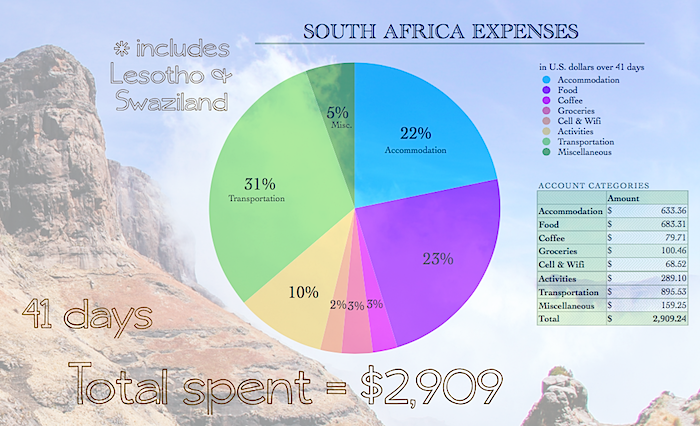
SOUTH AFRICA (spent an average of $70.95 USD per day)
South Africa is one of the few countries for which I wrote a full budget recap, so if you want more details click here to read my whole report.
- Currently my favorite country in the world. Do yourself a favor and add this to your must-visit list. It is super affordable — I didn’t do an overland tour here because it was easy to navigate on my own via bus and rental car. Average cost of a hostel dorm room (even in my favorite hostel!) is only $12 per night. Full steak dinners are also around $12. My morning latte cost under $2. And the landscape of South Africa is so gorgeous and varied — coastal views, wine regions, mountains in the Drakensberg, beaches with penguins, and wildlife in Kruger National Park. This country has it all. I spent six whole weeks here, but if you have a shorter time you’ll still be blown away by what you see. If I could recommend one way to spend your time, it would be to start in Cape Town for a few days and then rent a car to spend a week driving along the Garden Route.
- Blog discounts in South Africa: wine tour ($72), shark cage diving ($135), Cango Wildlife Ranch ($13), croc cage diving ($16), bungee jump ($72), kayaking Tsitsikamma National Park ($30), Baz Bus transportation ($260), Lesotho day trip ($45), Amphitheatre day hike ($45), Hawane Resort discount (savings of $15).
- No visa fee for this country!
- Miscellaneous expenses in South Africa: 3 new books ($24), overland guide tips for two 14-day tours ($40), 2 pairs of sunglasses ($20), postcards and stamps ($17), laundry four times ($14), Swaziland cultural group CD ($9).

So now you know exactly how much I spent to visit Africa. Now let’s look at how much I saved, thanks to various blog and photography discounts I hustled after when planning this trip.
- As mentioned above, I saved $3,075 combined from the 3 overland tour discounts. That helped the most.
- The other two tours I saved on were Kilimanjaro (savings of $821) and the Morocco tour discount (savings of $1000). Those also really helped.
- Other discounts were referenced under each country above, but I’ll recap them briefly here: one night in a Moroccan riad ($75), white water rafting and sunset cruise discount in Uganda (savings of $85), balloon ride in the Serengeti ($500), one night in a barn accommodation in Tanzania ($24), scuba dive discount in Zanzibar (savings of $65), helicopter ride over Victoria Falls in Zimbabwe ($150), Zambezi River sunset cruise ($50), flying fox zipline ($40), quad bike sand dunes tour in Namibia ($60), wine tour near Cape Town ($72), shark cage diving in South Africa ($136), Cango Wildlife Ranch ($13), croc cage diving ($16), bungee jump ($72), kayaking at Tsitsikamma National Park ($30), Baz Bus transportation ($260), Lesotho day trip ($45), Amphitheatre hike day trip ($45), Hawane Resort discount (savings of $15)
Which brings the grand total of savings to $6,652. And to recap, I spent $15,340 on this entire trip, so without the blog / photography discounts I would have spent $21,992 — a number way over my budget; I would have had to cut out a few countries. So these discounts allowed me to travel longer and see more places, thereby bringing more content to this blog and readers like you. Reaching out to travel companies for discounts has been good for me too from a professional development standpoint, as I’ve had to practice confidence in pitching myself and my photography skills. I usually do this via email in advance, but sometimes I have to do it in person upon arrival depending on the circumstances. It’s good exercise in how to present myself to tour operators or managers of travel-related companies.
One other note in regards to discounts — most companies are interested in use of my photos for their own websites and social media accounts, but they care less about the blog coverage because my site doesn’t draw huge numbers. So that is what I primarily use to barter my services, with the blog coverage as a bonus because I’d want to write about the experience and share the photos anyway.
WRAP UP…
I hope you’ve enjoyed this financial recap. I like being transparent about these costs because when people hear that I spent 4.5 months in Africa, it’s sort of unfathomable how much something like that costs. Seeing hard figures and pie charts makes it concrete. There’s less mystery about it; you can wrap your head around how to budget for a trip like this. Of course, you might have additional expenses to take care of back home — during the time of my trip, I was paying monthly fees for a storage unit in Los Angeles and still paying off my college loans. It’s not always easy to get away for a length of time, but it’s worth it.
Want to visit Africa but this sounds way out of your budget? Consider volunteering. It likely won’t be free, but hopefully you can get some of your expenses covered and then do some sightseeing before or after volunteering. Or consider going to one place and staying longer; that’s always cheaper than moving around a lot.

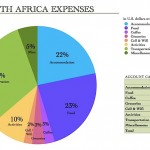
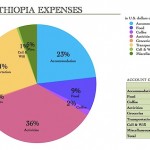
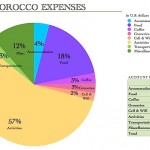
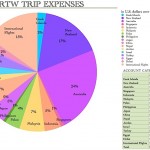
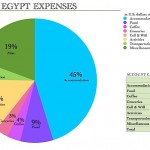
Thanks for all this awesome info!
You’re welcome! I’m so glad you found it useful!
Thanks for sharing your trip with us.
You are most welcome!!
This post was so interesting!!! Love all the little details. And your thoughts on travel being An education.
Thank you Kelley!! So glad you liked it!